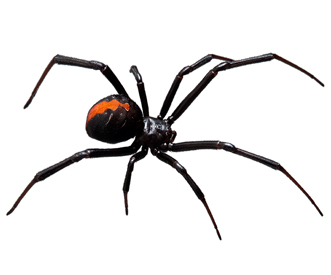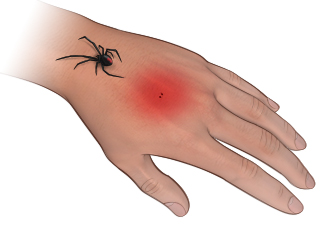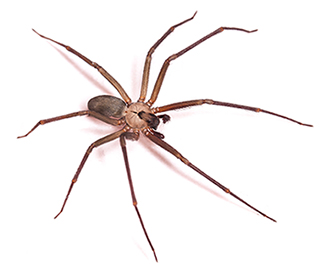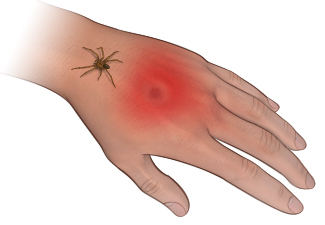When Poisonous Spiders Bite
Spiders are arachnids. This is the same group of animals that includes ticks, mites, and scorpions. All arachnids have 8 legs. Insects have only 6 legs.
No matter where you live, you'll find spiders in and around your home. Although all spiders have mouth parts that can bite, most spiders aren't dangerous to people. Depending on the type of spider, it's either because its venom isn't toxic to people, or its mouth parts aren't strong enough to bite through human skin.
There are two types of spiders found in the U.S. that can cause illness in people. One type is the widow spider. The black widow is the best known. The other type is the recluse spider. The brown recluse is the best known. A bite by either type usually isn't deadly, but it may make a person very sick. It's important to get quick medical help if you think you've been bitten by either type of spider.
Symptoms
You may not notice a bite by either a black widow or a brown recluse spider at first. The bite is often described as feeling like a pinprick or a light sting.
Children and spider bites
Children are more sensitive than adults to spider bites because of their smaller body size. But deaths from bites either of the black widow or the brown recluse are very rare. It is important to protect children from spider bites as the symptoms described below can be more severe in children
Treatment
If you are bitten by either a black widow or brown recluse:
-
Clean the bite with warm water and soap
-
Apply cold packs to avoid skin damage. To make a cold pack, put ice cubes in a plastic bag that seals at the top. Wrap the bag in a clean, thin towel or cloth. Don’t put ice or an ice pack directly on the skin.
-
Raise (elevate) the affected body part, if possible
-
See your healthcare provider right away or go to the emergency room
A medicine called antivenin is available for black widow bites, but none is available for brown recluse bites. The antivenin is only used in the most severe cases. Other treatment is mostly to ease symptoms. Clean the bite site and put a cold pack on it. Your healthcare provider will give you a tetanus shot if you are not up to date on that vaccine.
Preventing bites
Both the black widow and brown recluse spiders are shy and stay away from areas of a home with lots of activity or open spaces. They prefer quiet corners of a home, dark areas under seldom-moved furniture, garages, sheds, and wood piles. Neither spider is overly aggressive. They usually bite only when provoked or trapped against the skin.
Teach your children to not reach into areas where spiders may live without first checking to make sure no spiders are there. Webs and dead insects in an area are usually a sign that spiders are active there. Children also shouldn't play around rock piles and woodpiles.
If you do yard work that includes handling logs or leaves, wear gloves. Shake out any blankets or clothes, and check the inside of shoes that have been stored in an attic or basement before using them. Carefully check shoes or boots stored in a mudroom or garage before putting them on. It will also help to get rid of clutter, keep items off of the floor, store clothing and shoes in sealed plastic bags, and tuck bedding under mattresses so that nothing touches the floor.
You can limit the number of spiders in your home by having it sprayed with insecticide. Be sure to use only a licensed pest control company to do this. Insecticides carry their own risks, particularly if children, pets, or pregnant or nursing women are in the home.
Recognizing poisonous spiders
Widow spiders
 |
| Black widow |
There are five different species of widow spiders, including the black widow, in the U.S. Of these, only three are black. And only the black widow has the classic reddish orange "hourglass" shape on its belly. The bite of any of the widow types can cause a fairly severe reaction. The black widow causes the most frequent and severe poisonings. Black widows are not aggressive spiders unless they are provoked. They generally live in dark, quiet, undisturbed areas in and around a home, such as closets and basements.
If you are bitten by a black widow spider, the area of the bite may begin to swell and hurt after about a half hour. The venom of a black widow spider is a neurotoxin. This means it affects the nerves and the brain. These are symptoms of a black widow spider bite:

-
Muscle cramps or twitches, often near the site of the bite
-
Muscle spasms all over the body, sometimes within an hour of the bite
-
Severe belly pain, sometimes accompanied by nausea and vomiting
-
Increased blood pressure
-
Sweating
In severe cases, a person may become unconscious or stop breathing. Death from a black widow bite is extremely rare. If it does happen, it is more likely in children younger than 2 or in adults older than 50.
Recluse spiders
 |
| Brown recluse |
There are 12 species of recluse spiders, including the brown recluse, in the U.S. Only half of these are responsible for bites that have a major reaction in people. Most of the spiders in this group have a violin or fiddle-shaped marking on the upper part of their body. The base of the violin is at the front of the head and the neck of the violin points toward the rear of the spider. Besides the brown recluse, the other poisonous spiders in this group can be gray, orange, reddish-brown, or pale brown. Like the black widow, the recluse spiders like quiet, dark, undisturbed areas in and around the home. They are nighttime spiders, so they come out mostly at night or when the light is dim.
If you are bitten by a brown recluse spider, pain and itching at the site of the bite will begin to increase after 4 to 8 hours. The venom of a brown recluse spider is a tissue poison. This means it can severely damage the skin around the bite. These are symptoms of a brown recluse spider bite, in the order they appear:

-
Redness and swelling happen first at the site of the bite.
-
A blood-filled blister forms at the site soon after that.
-
An ulcer follows several days later, after the blister breaks and the skin falls away. The ulcer slowly gets bigger and creates a layer of dead issue. Some ulcers may reach 7 inches in diameter. Some of these ulcers need to be surgically repaired with skin grafts.
-
In rare cases, a person may have a life-threatening breakdown of red blood cells.
Other symptoms may include fever and chills, nausea and vomiting, joint pains, and rashes.